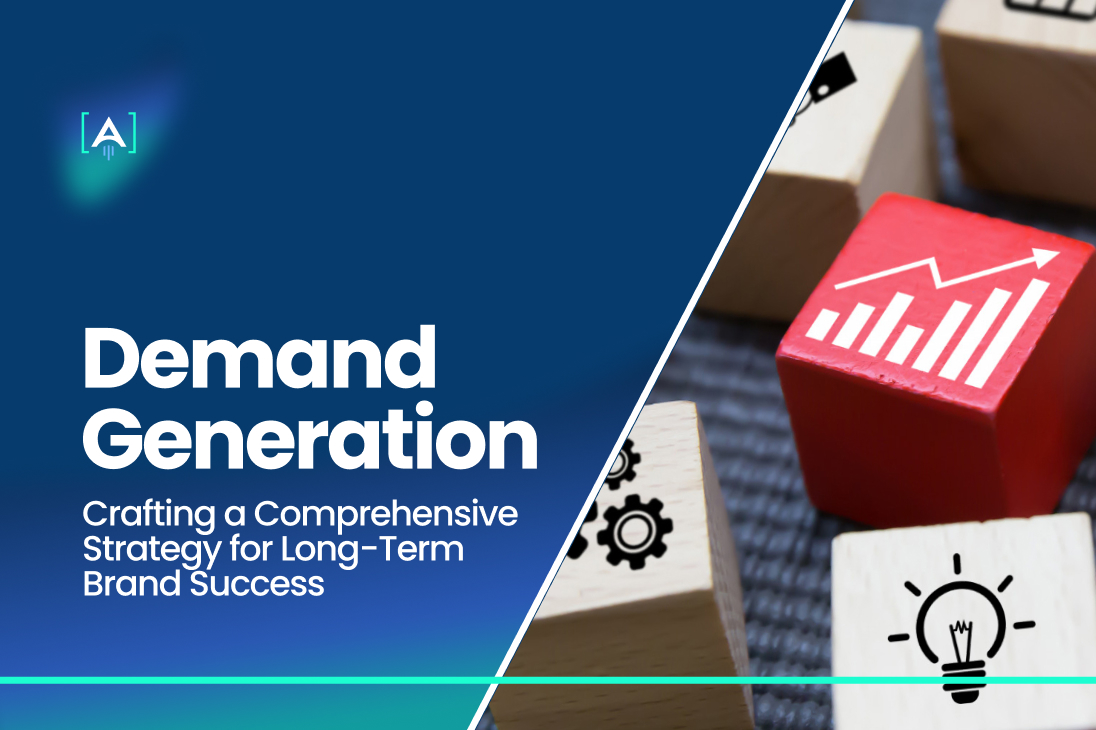In today’s competitive marketplace, passive marketing strategies don’t cut it.
You need a proactive, data-driven approach to create demand and position your brand as the go-to solution for your target audience.
Imagine your brand not just existing but drawing in your audience before they realize they need what you offer.
That’s the power of demand generation marketing.
Let’s explore what exactly demand generation marketing is, how it shapes the destiny of startups, and how it fuels the successful brand strategy of established brands.
What is Demand Generation?

Demand generation is the strategic process of cultivating interest and desire for your products or services among your target audience.
It’s creating a buzz about your brand without directly selling.
It’s a smart, long-term strategy focused on educating and engaging potential customers, even when they’re not actively buying.
Unlike quick sales tactics, demand generation aims to build lasting relationships and ensure your brand is the first choice when customers decide to purchase.
Demand generation marketing involves various programs that reach new markets, promote features, generate excitement, and maintain a strategic mindset for sustained success.
Growth marketing often works hand-in-hand with demand generation marketing and takes a more holistic approach. It focuses on nurturing those newly acquired leads and converting them into loyal customers.
By understanding the distinct roles of growth marketing vs demand generation, businesses can craft a comprehensive strategy that attracts new customers, keeps them engaged, and ultimately fuels sustainable brand growth.
The Significance of Demand Generation for Businesses
For startups and established brands, demand generation is essential for:
Building brand awareness: Creating a recognizable and trusted presence in the market.
Generating high-quality leads: Attracting potential customers who are genuinely interested in what you have to offer.
Nurturing relationships: Building trust and rapport with leads, turning them into loyal customers.
Driving sales and revenue: Ultimately, converting interest into tangible results.
Demand Generation Examples: Inspiring Strategies for Brand Growth
Here are how some companies applied demand generation strategies:
Dropbox’s Referral Program
This program incentivizes existing users to refer their friends with additional storage space.
This viral loop helped Dropbox acquire a massive user base and grow exponentially.
Grammarly’s Freemium Model
Grammarly offers a free plan with basic features and paid plans with more advanced features.
This incentivizes users to try the product, experience its value, and eventually upgrade to a paid plan.
Slack’s Integrations
Slack partnered with popular apps and services to allow users to integrate them directly within Slack.
This increased Slack’s value proposition and made it indispensable for many businesses and organizations.
Moz’s Free Tools and Resources
Moz offers many free tools and resources, like SEO reports and website analysis tools, that attract potential customers and establish them as a trusted authority in the SEO industry.
This builds brand awareness and trust, ultimately driving demand for their paid products and services.
Mailchimp’s Email Marketing Automation
Mailchimp‘s automation features allow businesses to create personalized email campaigns that trigger based on specific user actions and behaviors.
This customized approach enhances engagement and drives conversions.
Building a Solid Foundation: Understanding Your Market

Before creating a demand generation marketing strategy, you must do market research. This involves three key aspects:
Researching and Identifying Your Target Audience: It’s crucial to know who you’re trying to reach. Who are your ideal customers? What are their needs, desires, and pain points?
A survey revealed that 57% of B2B marketers employed chatbots in their demand generation programs to deeply understand their audience.
Analyzing Market Trends and Competitor Strategies: Stay informed of the market trends and innovations. Analyze current trends, identify emerging technologies, and understand how your competitors position themselves.
The Role of Customer Insights in Shaping Demand: By listening to your customers’ feedback, understanding their needs, and analyzing their behavior, you gain insights that can shape your entire demand generation strategy.
Use surveys, customer interviews, and social media listening to gather these insights and translate them into actionable strategies.
Developing a Content Strategy that Resonates

Now that you’ve laid the groundwork by understanding your market, it’s time to build your content.
After all, in the digital age, content is the fuel that powers your demand generation engine, attracting and engaging your target audience.
So, how do you create content that truly resonates?
Know Your Audience: Remember those customer personas you created? They’re your guide. Create your content based on their specific interests and preferred formats. Are they visual learners who crave infographics and videos? Or do they prefer in-depth blog posts with actionable insights?
Speak Their Language: Ditch technical jargon and industry speak. Use clear and digestible language that your audience can easily understand. Be authentic and conversational, and inject your brand identity into your content.
Offer Value: Don’t just talk about yourself. Create valuable content for your audience. Inform them, educate them, entertain them, and solve their problems.
Mix it Up: Don’t get stuck in a rut. Use different content formats to keep things interesting. Blog posts, videos, infographics, social media posts, e-books, webinars – the possibilities are endless!
Consistency is Key: Building an audience takes time and dedication. Publish your content regularly to nurture relationships. Consistency builds trust and ensures your audience always has something new and engaging to consume.
Quality Counts: Don’t rush your content. Prioritize quality over quantity. Invest in creating well-written, informative, and visually appealing content that reflects your brand values. Don’t underestimate the power of brand positioning.
Leveraging Digital Platforms for Maximum Reach

Once you create content, you must amplify it and connect with your audience.
But with so many options available, choosing the right channels for your brand strategies and leveraging them effectively is crucial.
In a survey of global B2B marketers in March 2022, 45% said webinars are the best at bringing in initial interest.
Choosing the Right Digital Channels
Not every platform is created equal. Identify which digital channels your target audience frequents: Facebook, LinkedIn, YouTube, or industry-specific forums.
Consider factors like demographics, interests, and online behavior patterns.
Don’t spread yourself too thin; focus on mastering the platforms that can deliver the most significant impact for your brand.
Share valuable content, participate in conversations, and run targeted ads to reach new audiences.
Integrating Social Media into Your Strategy
Social media isn’t just about likes and shares; it’s a powerhouse for brand visibility.
Create a comprehensive brand strategy that resonates. Interact with your audience, and don’t shy away from the occasional behind-the-scenes glimpse.
Building a community around your brand is like planting seeds that grow into loyal followers.
The Importance of SEO and Online Presence
In the vast jungle of the internet, SEO (Search Engine Optimization) is your compass.
Optimize your website, sprinkle it with keywords your audience is searching for, and watch as your online presence blooms.
A well-designed and user-friendly website will encourage visitors to stay longer, explore your offerings, and ultimately convert into leads.
Engagement Strategies: Building and Nurturing Relationships

It’s time to anchor down and build meaningful connections with your audience.
Remember, engagement is the heartbeat of lasting relationships in business.
Techniques for Engaging with Your Audience
- Be Responsive: Show your attention by replying swiftly to comments and messages on social media and your website. It lets your audience know their input matters and that you’re keen on building a connection.
- Host Giveaways and Contests: Everybody loves freebies! Running contests and giveaways is a lively way to encourage participation, generate buzz, and expand your audience.
- Spark Interaction with Campaigns: Polls, quizzes, Q&A sessions, and AMAs are fantastic tools to get your audience involved. Beyond the fun, you gather valuable insights, understand your audience better, and foster community.
- Team Up with Influencers: When the marketing team partners with influencers in the field, their existing audience significantly broadens your reach. Pick influencers aligned with your brand values and whose followers match your target market.
- Cultivate a Community: Building a community around your brand is like creating a loyal tribe. Encourage conversations, user-generated content, and peer-to-peer connections. This sense of belonging turns your audience into enthusiastic brand advocates.
Remember, a strong customer-centric approach seamlessly integrates engagement strategies with a robust retention strategy. By consistently interacting with your audience and addressing their needs, you build trust and loyalty, ultimately leading to a more sustainable customer base.
A growth marketer, for instance, leverages engagement tactics to nurture existing customers. They might use contests or targeted social media campaigns to rekindle interest and encourage repeat business.
Creating a Community Around Your Brand

Beyond individual engagement, fostering community in demand generation marketing is crucial for long-term success. Here’s how:
Create a dedicated online space: This could be a forum, a private social media group, or even a subsection of your website. This space allows your audience to connect, share experiences, and support one another.
Host online and offline events: Organize webinars, meetups, or virtual conferences to unite your community. This provides valuable networking opportunities and strengthens the bond between your brand and audience.
Recognize and reward your community members: Show your appreciation for active members by highlighting their contributions, offering exclusive benefits, or even rewarding them with your products or services.
Strategies for Nurturing Leads into Loyal Customers
Turning potential customers into devoted fans is the gold standard in business. It’s a strategy used in customer centric marketing. Here are some strategies to guide you on this journey:
- Educate and Add Value: Share informative content that helps your audience. Whether it’s how-to guides, tips, or industry insights, providing value positions your brand as a reliable source. An educated lead is often a loyal customer.
- Personalize Your Approach: Tailor your communications. Address leads by their names and send personalized recommendations based on their preferences.
- Stay Consistent with Communication: Regularly update your leads about new products, promotions, or relevant industry news.
- Offer Exclusive Benefits: Create a sense of privilege. Provide exclusive offers, early access to sales, or loyalty programs. Feeling special makes leads more likely to choose your brand over others.
- Encourage User Reviews and Testimonials: Positive reviews build trust. Encourage satisfied customers to share their experiences. Authentic testimonials act as social proof.
- Create Seamless Buying Experiences: Simplify the purchase process. A smooth, user-friendly buying experience reduces friction and encourages repeat business.
- Follow Up After Purchase: Don’t disappear after the sale. Send post-purchase emails expressing gratitude, seeking feedback, and offering assistance. This post-purchase care cements the relationship.
Data-Driven Decisions: The Role of Analytics in Demand Generation

Thriving in the dynamic marketing landscape demands more than intuition and guesswork.
Data is the fuel that drives successful demand generation, allowing you to refine your strategy, understand your audience better, and optimize your efforts for maximum impact.
Here are some key ways to use analytics in your demand generation strategy:
- Track key metrics: Monitor website traffic, social media engagement, lead generation, and conversion rates. These metrics provide valuable insights into what’s working and where you need to improve.
- Customer journey mapping: Analyze the different touchpoints your customers encounter throughout their journey with your brand. This helps you identify areas for improvement and personalize your messaging for each stage of the journey.
- Attribution modeling: Understand which marketing channels are contributing most to your conversions. This helps you use your resources wisely, focusing on the channels that give you the best results.
Email Marketing: A Timeless Tool in Your Arsenal

Used strategically, email marketing becomes a powerful tool in your demand generation toolkit.
Practical Email Marketing Tips
With best practices, personalization, and segmentation, email marketing becomes a tool to nurture leads, build relationships, and boost conversions.
Engage leads, show you care through personalized messages, and drive sales by directing traffic to your website.
- Targeted Lists: Create lists based on demographics, interests, and behavior for personalized content that connects with each recipient.
- Catchy Subject Lines: Your subject line is the first impression. Keep it clear, short, and intriguing to boost open rates.
- Personalized Content: Skip the generic stuff. Personalize your content to your audience’s interests.
- Mobile-Friendly Design: Since over half of emails are opened on mobiles, ensure your emails look good on smaller screens.
- Clear Call to Action: Guide your readers on what to do next, whether visiting your site, downloading content, or purchasing. Make it compelling.
Innovative Tactics: Staying Ahead of the Curve

You must explore emerging marketing techniques to thrive in the ever-evolving marketing landscape.
Here are some ways to stay innovative in your demand generation strategy:
- Experiment with new technologies: Keep your finger on the pulse of emerging technologies like AI marketing, virtual reality, and augmented reality. These technologies offer exciting opportunities to create immersive experiences, personalize marketing messages, and deliver targeted content to your audience.
- Explore alternative marketing channels: Don’t limit yourself to traditional channels. Consider experimenting with niche platforms, influencer marketing, and content partnerships to reach new audiences and expand your reach.
- Embrace data-driven creativity: Use data to fuel your creative process. Analyze customer behavior, track trends, and use insights to inform your content strategy and campaign development.
- Stay agile and adaptable: Adapt swiftly to shifts in the market, competitors, and customer preferences, as consumer behavior is constantly changing. Modify your strategies and tactics promptly.
- Foster a culture of innovation: Promote an innovative culture by inspiring experimentation and creativity among your team. Establish an atmosphere where employees feel empowered to explore new ideas and take risks.
Budgeting Wisely: Allocating Resources for Optimal Impact

Even the most innovative demand generation strategy won’t succeed without a solid financial foundation.
That’s where budgeting comes in. By planning and allocating your marketing budget wisely, you can ensure your resources are used effectively and deliver the best possible return on investment (ROI).
Here are some key steps to budgeting wisely for your demand-generation efforts:
Set clear goals: Before allocating funds, define your marketing goals for the year. What do you want to achieve? How will you measure success? Having clear objectives helps you determine where to invest your resources.
Analyze your current spending: Look closely at your past marketing expenses to understand where your money is going. Identify areas where you can cut back or optimize spending.
Research and compare costs: Different marketing channels have varying costs. Research the average cost per lead and conversion rate for each channel you’re considering. This helps you allocate your budget strategically.
Focus on ROI: Every marketing expense should be considered an investment. Track the ROI of each campaign and channel to see what’s working and where you need to make adjustments.
Balancing Between Various Marketing Channels
Traditional vs. digital marketing: Consider allocating your budget based on your target audience’s preferences and behavior. Are they more receptive to traditional channels like print advertising or prefer online marketing experiences?
Paid vs. organic marketing: While paid advertising can quickly boost, organic marketing strategies like SEO and content marketing offer long-term benefits. Balance your budget between these two approaches to ensure sustainable growth.
Brand awareness vs. direct response: Determine your campaign’s primary objective: building brand awareness or driving immediate conversions. Allocate your budget accordingly.
Sustainability and Ethics in Demand Generation

In today’s increasingly conscious world, consumers demand transparency, accountability, and brands that align with their values.
That’s where sustainability and ethics become crucial aspects of successful demand generation.
Ensuring your strategies are sustainable and ethical.
Ensuring your strategies are sustainable and ethical involves several key aspects:
- Transparency: Be open and honest about your marketing practices. Communicate your data collection methods, use of cookies, and privacy policies.
- Responsible data usage: Collect and use data ethically. Obtain informed consent, ensure data security, and avoid discriminatory practices.
- Consider the environmental impact: Choose eco-friendly materials, reduce waste, and embrace digital alternatives for your marketing campaigns.
- Diversity and inclusion: Represent your audience authentically and respect diverse voices and perspectives. Avoid stereotypes and promote inclusivity in your messaging and visuals.
- Fair and honest advertising: Avoid misleading claims, deceptive practices, and manipulative tactics in your marketing materials. Promote your products and services truthfully and ethically.
The Long-Term Benefits of Ethical Marketing Practices
Ethical marketing isn’t just a buzzword; it’s a roadmap to sustainable success. Here’s why:
Builds Trust: Ethical practices foster trust with your audience. Customers who believe in your integrity are more likely to stay loyal.
Enhances Reputation: Ethical choices contribute to a positive brand image over time. A good reputation is a valuable asset in the long run.
Customer Loyalty: Happy customers stick around. When you demonstrate ethical values, you establish a loyal customer foundation that chooses your brand over others.
Word-of-Mouth Marketing: Satisfied customers become your brand ambassadors. They’ll recommend your products to friends and family, creating a ripple effect.
Sustainability: Ethical practices contribute to the longevity of your business. You align your brand with a sustainable future by considering environmental and social impacts.
Adaptability: In an ever-changing market, ethical brands tend to adapt better. Customers appreciate companies that evolve responsibly.
Legal Compliance: Operating ethically ensures you’re on the right side of the law. Avoiding legal troubles preserves your brand’s long-term stability.
Employee Morale: A company with strong ethical values attracts and retains top talent. Employees feel proud to be part of an organization that does the right thing.
Demand Generation is a Journey, Not a Destination

Crafting a comprehensive strategy with the help of a growth marketing agency for long-term brand success goes beyond generating leads and achieving short-term gains.
It’s about building a sustainable growth engine that fosters trust, loyalty, and engagement with your audience.
By understanding your market, creating valuable content, leveraging digital platforms, and embracing data-driven decision-making, you can establish a solid foundation for your demand-generation efforts.

